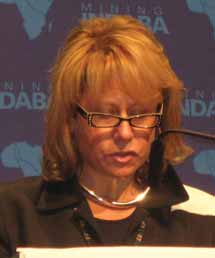
At the bottom of Impala’s new 20 shaft under construction. The shaft will begin its production build up in
January next year, but South Africa’s power shortage threatens future expansions.
Power Shortages, Safety Issues Hindering South African Mining Industry

With the broad swath of commodity prices, ranging from gold, to platinum to iron ore, at unprecedented highs, South Africa’s mining industry should have been in a state of euphoria. It was not.
This had little to do with South Africa relinquishing to China the title it held for over a century as the world’s No. 1 gold producer, nor the tremors sent around the world by the sub-prime crisis. Henk Deist, who heads the resource finance division of one of South Africa’s four big banking groups, Rand Merchant Bank, said that while the cost of capital has gone up this year by some 50 or 60 basis points, the extreme supply side crunch for mineral commodities means little has changed in terms of mining projects’ access to funding. Deist said that what has changed the environment for mining projects in South Africa is the shortage of power.
During the late 1990s, like many other parts of the world, South Africa embarked on an initiative to privatize its power sector. The national power utility that provides most of the country’s electricity, Eskom, was told new capacity would be built by the private sector. However, privately owned capacity never materialized because the extremely low price of electricity in South Africa inhibited any new entrants. Eskom only began building new capacity in 2004, too late considering the lead times for power projects.
But even those who saw it coming were stunned by the degree of the power crisis when it struck. On January 21, 2008, Eskom told South Africa’s mines it could not guarantee them power. On January 24, following extensive rolling blackouts across the country, in part due to coal handling problems at power stations associated with heavy rainfalls coupled with a misguided policy by Eskom management to run down its coal stockpiles, the national power grid threatened to become unstable. South Africa’s deep level mines were forced to cease operations, something that had not happened since the Boer war.
Only on January 29 did Eskom ramp up electricity supply to provide the mines with 80% of their former power requirements. Later this was raised to 90%, a situation the mines were told they could expect to last until 2012.
While power was cut back to the mines, regular supply continued to the commercial and residential sectors. The mining industry in South Africa uses about 15% of the power supplied by Eskom, which translates roughly into 4,500 megawatts (mw).
Since then various people such as economist Moeletsi Mbeki, brother and critic of President Thabo Mbeki, have spoken out on how this approach is devoid of economic logic. Mining is responsible for some 50% of South Africa’s foreign exchange earnings derived from the exports of merchandise, in a country running one of the world’s largest current account deficits in a nervous global environment. It would be better for the country’s economy to target the commercial and residential sectors for power outages, sectors that have more flexibility to cut back on energy use.
David Brown, CEO of the world’s second largest platinum producer, was one of many to express his frustration: “They said supply of 90% of power levels could exist for four to five years—what kind of solution is that? Mining is an expanding industry which provides foreign currency and employment, and saying it has to cut at least 10% on a short to medium-term basis just does not make sense—there are some issues that are clearly not being dealt with.”

Gold Fields, which operates some of the world’s deepest mines, said the 10% power reduction meant sustainable production at its South African operations was likely to decline by between 15% and 20%. To achieve the 10% reduction in electricity consumption Gold Fields announced it would mothball or scale back work at a number of its Driefontein and Kloof mine shafts and cancel depth extension projects. It would also have to retrench 6,900 of 53,000 employees.
Subsequently the deep level mining industry was told it would be able to increase power to 95% of previous levels, with those mines most threatened by job losses to be prioritized. The government has subsequently also said it can’t let industry, and mining in particular, take the brunt of the crisis and the cutbacks in power must be shared more evenly.
However, new projects, particularly those involving furnaces, are being put on hold. Unlike the rest of the continent where mining projects have to ensure access to transport infrastructure, water and power, it was always taken for granted that projects in South Africa would have access to these. “Even for greenfield mining projects where electricity agreements are already in place, the robustness of these projects has to be recalibrated to take into account variables in the quality and continuity of such supply,” Deist said.
Health and Safety Are Also Concerns
When the Indaba began, two weeks after
the power crisis broke, South Africa’s mining
sector was in no mood to celebrate.
Even before the power crisis, South Africa’s
deep level underground mining industry
found itself at the edge of a cliff, confronted
by a government that would no longer
tolerate its unacceptable safety and health
record. Toward the end of 2007 mine safety
became increasingly politicized. Production
sensitive deep level shafts were
forcibly shut for periods after work related
fatalities.

On a per sector basis, the problem areas stand out glaringly. Gold mining in South Africa has double the fatality rates at 0.34 per million hours worked compared with 0.17 for platinum and 0.16 for coal mining. South Africa’s gold mines remain the major contributors to traumatic injuries, at an average of seven per million hours worked. South Africa’s expanding platinum sector has also shown an increase in the wrong direction, with four traumatic injuries per million hours worked in 2007, up from three per million hours in 2003.
Even accepting that there is a natural seismic risk, it has been used too much as an overall excuse and there remains huge scope for improvement. “As much as 80% or more of fatalities and traumatic injuries are not related to unpredictable seismic events,” said May Hermanus, professor, director of the Center for Sustainability in Mining & Industry, and former Inspector of Mines. “Casualties attributed to general causes account for over 40% of the total in all mines, and transportation and machinery related incidents account for another 25% to 40%.”
Agreement on what should be achieved regarding mine health and safety is pretty much unanimous, as is a commitment to South Africa’s mining industry achieving fatality and injury rates in line with international benchmarks. A South African Chamber of Mines study in 2004 showed the industry’s safety performance to be more than 50% worse than the benchmarks in Canada, Australia and the United States, requiring an improvement of 30% a year in South Africa’s gold mines to reach a desired target of 0.04 fatalities per million hours worked by 2013.
New Mining Legislation Has Not Helped
the Situation
And even before it was struck by the power
crisis and clamp-down on mine safety,
South Africa was failing to benefit fully from
the international boom in mineral commodities.
Peter Leon, partner in legal firm
Webber Wentzel Bowens and senior vicechair
of the International Bar Association’s
Mining Law Committee, said at a
dinner hosted by Merrill Lynch during the
Indaba week that South Africa’s new mining
legislation has played a major role in this.

The MPRDA contains provisions where the old order rights holders must convert their rights to the new system over a five year period which expires at the end of April 2009.
The theory was to allow more equitable access to mineral rights and create more opportunities for more people in a previously locked up sector. However, Leon said, the effect of this conversion process flatters to deceive as it replaces the old order rights with what are limited real rights of greatly diminished substance. In addition, the new order rights are of limited duration and may only be disposed of or transferred with the DME’s consent. In other words they are not freely transferable and tradable.
Of the 6,567 prospecting rights applications received by the DME between May 2004 and May 2007 only 2,834 were granted, while 3,302 were refused or returned to the applicant for further information. And as Leon says, it is not because the mining companies and their consultants are remiss in preparing the documentation— it is because of the high subjectivity of the process.
The subjectivity of the process was illustrated in a keynote Indaba speech by Anglo American CEO Cynthia Carroll. More than one delegate described her address as sycophantic, a speech seemingly aimed not primarily at the audience, but at South Africa’s minister of minerals and energy, Buyelwa Sonjica. A few days later Anglo American had all its old order mineral rights converted to new order rights after years of failure to achieve this.
In her Indaba keynote address, given just before Carroll’s, Sonjica said the government will continue to amend the MPRDA. Leon says it is encouraging that the MPRDA will be addressed in parliament this year, but the fact that no detail was given was somewhat disappointing.

Manager of the large bore hose division of a company called Truco Projects, which has captured a large chunk of Africa’s mining sector rubber hosing market, Mike Stuart best sums it up. “We are tracking some 550 projects in Africa, ranging from start of pre-feasibility to construction activity on site and these are all genuine nonspeculative projects with an 18 month implementation horizon. Some four to five years ago there were only about six or seven projects at similar levels.”
Gary Bell, group CEO of Bell Equipment, South Africa’s home grown mobile equipment manufacturer, says Africa has been the fastest growing segment of the internationalized company’s business. He has seen a lot of vigor in the mining sector, with the coal mining set to boom in South Africa and with massive mining projects under way in other parts of the continent. Even taking the worst case scenario in South Africa and internationally, there looks to be a growing market for the company. “The worst case scenario according to South African Federation of Civil Engineering Contractors GDP growth scenarios is a growth rate of 2% and at that level or above there are enough peripherals and replacement cycles to keep business going comfortably,” Bell says.
Carroll said Africa still accounts for a high proportion, nearly $4.5 billion, of Anglo American’s ongoing project pipeline, which amounts to some $12 billion. The company’s exploration expenditure in Africa will rise from $38 million in 2006 to $65 million this year. Carol did also point out that in terms of security of energy supply South Africa is not alone, with Chile, Brazil, and China also experiencing similar pressures.

“Anglo American is the largest mining company in South Africa and has been at the forefront of creating sustainable BEE over many years,” said Sandile Nogxina, director-general of the DME. “We welcome the strong spirit of cooperation between Anglo American and the DME and look forward to a continued relationship which is both positive and productive.”
Anglo American’s Cynthia Carroll said that she was delighted with the progress that the company has made toward its goal of establishing significant and meaningful BEE across all its businesses in South Africa and that agreement has been reached regarding Anglo American’s new order mining rights. “This is a landmark achievement for the group and for the many black empowered businesses with which we are partnered,” said Carroll. “It provides our business with greater certainty in South Africa and enables the group to continue to make a strong contribution to South Africa’s prosperity and economic growth.”.